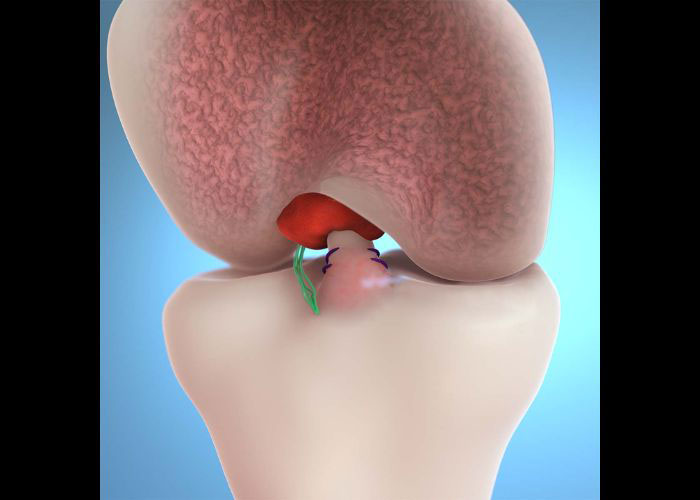What is osteochondritis dissecans of the capitellum?
Osteochondritis dissecans (OCD) of the capitellum is a condition in which the blood supply to the elbow joint is compromised. The capitellum is the area where the bony prominence on the lateral humerus (upper arm bone) articulates with the head of the radius (thumb side forearm bone). Surrounding these bone ends is a layer of slippery and shiny connective tissue that provides painless joint movement. Underneath this articular cartilage is a subchondral bone layer that contains a healthy blood supply for the elbow joint. The lack of nutrients from damage to this network of blood vessels can result in necrosis (cellular death) of the subchondral bone which can then lead to separation of the subchondral bone. Often times, repetitive motions of the elbow such as throwing a baseball or participating in gymnastics, can lead to this problem.

What is the treatment for osteochondritis dissecans of the capitellum?
Patients with early confirmation of osteochondritis dissecans (OCD) of the capitellum generally benefit from initial non-surgical treatments. A brace or splint may be applied for elbow joint immobilization. It is highly encouraged to avoid any activities that may worsen symptoms such as throwing and gymnastics. Rest, ice, and non-steroidal anti-inflammatory medications (NSAIDs) can alleviate any pain and inflammation associated with this condition.
However, surgical intervention is often necessary for patients who failed to respond to non-surgical therapies, when loose bone fragments are left floating in the joint space, or this condition is recognized as unstable. There are a number of surgical techniques available to surgically repair the elbow joint; each method aims to restore the elbow joint blood supply and improve joint function. Dr. Ronak Mukesh Patel, orthopedic elbow doctor, treats patients in Sugar Land, Pearland, and the Houston, Texas area, who have experienced osteochondritis dissecans of the capitellum and are in need of surgical treatment.
How is osteochondritis dissecans of the capitellum treated?
Because of the various techniques that can surgically repair osteochondritis dissecans (OCD) of the capitellum, Dr. Patel will review several factors to determine the best surgical approach. These techniques are highly individualized to each patient’s specific condition, therefore should only be performed by an orthopedic elbow doctor that is extensively trained in treating OCD of the capitellum. Surgical techniques to treat osteochondritis dissecans of the capitellum may include:
- Debridement: Arthroscopic debridement is a minimally invasive procedure involving a small camera (arthroscope) and specialized surgical instruments to remove any irregularities, such as scar tissue, bone spurs, damaged tissue, or loose bodies left floating within the joint space.
- Microfracture: This technique treats focal cartilage defects by creating small openings within the subchondral bone. These holes allow bone marrow and stem cells to infiltrate the elbow joint and stimulate new fibrocartilage growth over the exposed bone.
- Osteochondral Autograft/Allograft Transplantation Surgery (OATS): This procedure harvests a cartilage graft, from either the patient (autograft) or donor (allograft), which is shaped to the patient’s specific areas of damaged cartilage. The cartilage graft provides a surface for new cartilage to grow by being attached directly to the native cartilage.
What is the recovery period like after osteochondritis dissecans of the capitellum repair?
The recovery period following osteochondritis dissecans (OCD) of the capitellum repair is largely determined by the particular surgical technique performed by Dr. Patel. In general, patients in Sugar Land, Pearland, and the Houston, Texas area can expect elbow joint immobilization with a brace or another device for several weeks following surgery. Any post-operative pain and inflammation are controlled with a combination of rest, ice, and non-steroidal anti-inflammatory medications (NSAIDs). Passive physical therapy exercises typically begin within the first 7 days after surgery and gradually progress into active exercises. Full recovery from surgery depends on the type of surgery performed and the patient’s sports activities.
Elbow OCD Repair Surgeon

If you participate in sports activities like gymnastics or throwing, you may be susceptible to an elbow condition called osteochondritis dissecans (OCD) of the elbow. In many cases, OCD of the elbow can be treated with surgery. Elbow OCD surgeon, Doctor Ronak Mukesh Patel, provides diagnosis as well as surgical and nonsurgical treatment options for patients in Houston, Sugar Land, and Pearland, TX who have been diagnosed with osteochondritis dissecans (OCD) of the elbow. Contact Dr. Patel’s team today!








